Magical Towns in QUINTANA ROO
México » States » Quintana Roo » Magical Towns
Magical Towns in QUINTANA ROO
Get to know the Magical Towns of the State of Quintana Roo: Isla Mujeres, Tulum and Bacalar and marvel at their stories, with their archaeological sites, their turquoise waters, ecotourism and adventure activities. Here you will learn about the ancient Mayan civilization, whose essence remains to this day.
You will learn about the work of artisans, whose expertise is passed from generation to generation and you will delight in the mixtures of smells and flavors of the exquisite gastronomy of the region.
Bacalar, Tulum and Isla Mujeres have something in common: They both offer destinations surrounded by the most beautiful beaches in Mexico and that represent fresh and different alternatives for national and foreign visitors.
But despite having beaches among its main characteristics, each one of them also has its own charm that have made them winners of the title of magical towns of Quintana Roo.
This award granted by the Ministry of Tourism in collaboration with various governmental bodies and state and municipal governments, contributes to revalue this group of populations -as well as 108 more- and its inhabitants, who have managed to save for all, the cultural wealth and historical that they enclose.
The charm of Isla Mujeres cannot be measured by its size, since at just eight kilometers long by half width, the traveler finds so many attractions to choose as a vacation spot that he soon forgets the tiny dimensions of the island.
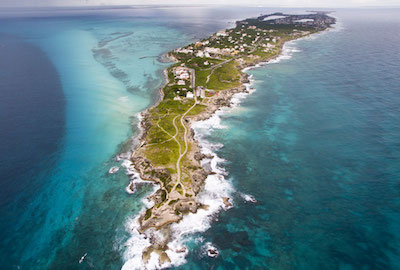
North of Cancun, in the State of Quintana Roo Isla Mujeres has positioned itself as a tourist alternative to the Riviera Maya, much more relaxed and allowing you to enjoy the same charms of the Caribbean Sea. Destination of Honeymoons and Honeymoon, Isla Mujeres welcomes travelers with good treatment throughout the year.
Locals call Isla Mujeres simply “Island”, and its friendly character invites you to chat with them about the local economy, based on tourism, diving and fishing.
As in Cozumel, the French oceanographer Jacques Cousteau fell in love with the seabed and the reef of Isla Mujeres. Guided by the local diver Ramón Bravo, Cousteau immortalized the underwater fauna and flora, and showed it to the whole world with his unforgettable reports.
History of Isla Mujeres
Legends say that the buccaneers left their women here when they went out to sail the sea looking for the Spanish ships that returned to Spain with the “treasures” plundered.
Others affirm that when the expedition of Francisco Hernández de Córdoba arrived in 1517 he observed that there were numerous sculptures of women who were given in offering to the Mayan goddess Ixchel, adoration of fertility, for which they assigned the name of Isla Mujeres.
The Mayan ritual forced the girls to come to the island to make an offering to the goddess of Ixchel, who on their way to adulthood begged for fertility.
Tourist Attractions in ISLA MUJERES
Its transparent, warm, shallow and full of life waters are a paradise for divers, whether they are professionals or amateurs. For this reason, if we like to dive, the possibilities are endless, either simply by snorkeling on our own or with tours that take us by boat to caves and areas further away from the beaches.
Isla Mujeres is the first place in Mexico to receive the sun’s rays, since it is located at the eastern end of the national territory. Even with the notable tourist development in the excellent hotels, shops and restaurants, the island has managed to preserve that village touch that makes it different from other places in the region.
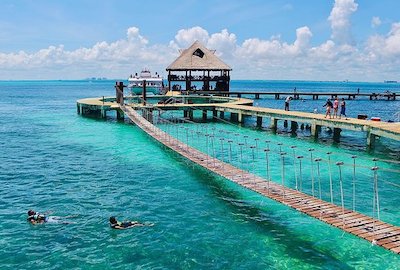
Garrafón Arrecifes Natural Park
Garrafón is a park known for its quiet beaches and beautiful reefs, making it one of the favorite places to snorkel on Isla Mujeres. Taking a relaxing kayak trip over numerous colonies of tropical fish is an unforgettable experience, as well as living the extraordinary adventure of zip-lining over the sea.
Garrafón is part of the longest coral reef in the northern hemisphere and is a marine ecosystem where a huge population of endangered species subsists.
North Beach
Playa Norte is one of the most famous beaches in Quintana Roo. It is a site with calm and shallow waters that little by little has positioned itself as the favorite of the island’s tourists. This place is easily accessible from the pier and houses one of the most renowned beach hotels on Isla Mujeres.
Punta Sur
Being a site of imposing cliffs, of which the highest reaches 20 meters above sea level, Punta Sur offers the opportunity to admire majestic sunrises and impressive views of the Hotel Zone of Cancun and the Caribbean. For this reason, Punta Sur is one of the tours in Isla Mujeres that you cannot miss.
Punta Sur permanently exhibits pieces by 23 artists from different countries, all of them large outdoor sculptures. It is also home to a small Mayan temple in which tribute was paid to the goddess Ixchel and which served as a guide light for merchants.
Tortugranja (Turtle Farm)
Between May and September of each year, huge sea turtles arrive at Isla Mujeres to lay their eggs in the warm sand. In the “Tortugranja”, one of the main attractions in Isla Mujeres, visitors can observe hatching hatchlings and how adult animals are protected in a vulnerable state. In time, the turtles are released into the sea by the children of the local schools as an important educational activity.
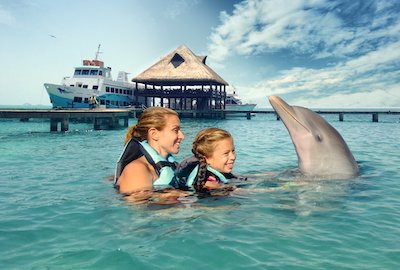
Dolphin Discovery
Dolphin Discovery Isla Mujeres offers the opportunity to live with dolphins and swim with them. Stroking them, shaking their fins or receiving a kiss, as well as diving at a beginner or professional level, are some activities that you can do with these mammals that are the protagonists of one of the best known tourist attractions in Isla Mujeres.
Dolphin Discovery also offers you the eco-educational experience of contact with other animal species, such as bull sharks, manta rays, monkeys, toucans and macaws.
Hacienda del Pirata Mundaca
They are worth visiting the vestiges of the farm that was the home of one of the most important characters in the Caribbean: the Pirate Fermín Antonio de Mundaca y Maréchega, who was an architect, poet, merchant, farmer, slave trader, and definitely a feared privateer.
Fermín de Mundaca built a hacienda to try to win over a local woman known as “La Trigueña”, but even so he never managed to win her heart. At present, the enclosure has been used to install a small zoo with beautiful specimens of the local fauna and beautiful gardens.
Contoy Island
Located 45 minutes north of Isla Mujeres, Isla Contoy National Park is a protected natural area declared by government authorities as a “Wildlife Refuge”, so no person can live there. Turtles and numerous colonies of birds such as pelicans, herons and frigates, have survived the serious threat of extinction of their species, since they cohabit, nest and reproduce in Isla Contoy without the predatory harassment of the human being.
There are several alternatives for walks and departure times to Isla Contoy, although the number of visitors is limited for reasons of environmental protection. Without a doubt, Isla Contoy is one of the most interesting places to visit in Isla Mujeres.
Bacalar is located 25 Miles north of Chetumal and the charming of the village sneaks up on unsuspecting visitors and engulfs them slowly. By itself, it is a town possessing all the features to be named a Magic Town, a title it received in 2006.
It was founded as a Mayan village named Siyan Ka’an Bakhalal in 435 AD. Years later Bacalar became contested ground ever since the Spanish conquistadors wrested it from the Mayas in the 1530’s, and Don Gaspar Pacheco refunded the village with the name of “Villa de Salamanca de Bacalar” in 1544.
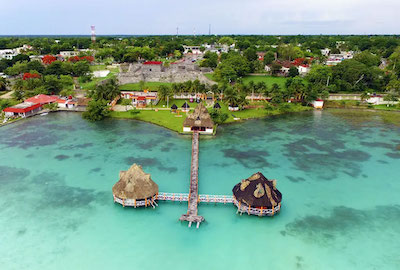
Later years saw the Spaniards fighting off marauding English pirates mining the red gold of the palo de tinte tree for expensive clothing dyes. And still another conflict erupted in the mid 1800s, the Caste War, that took over Bacalar as stronghold. Today, in contrast, Bacalar has a very nice provincial atmosphere with its colonial architecture and history that interweave with the blue turquoise waters of the lagoon, known as the Lagoon of Seven Colors.
Every August, the town of Bacalar celebrates the Fair of San Joaquin of Bacalar, an annual event eagerly awaited by the people. For nine consecutive days, different neighborhoods host festive celebrations. Visitors are welcome and should definitely join the fun —expect plenty of food, music, dancing, performances of all sorts, and a three-day hydroplane race, among other things.
Something Unique In BACALAR
While the blue hues are impressive, what’s even more unique about the lagoon is its high concentration of stromatolites: rare rock formations that are among the earliest life forms on earth, with over 350 millions years in the planet.
According to the scientists, these living stones were the backbone of all life on Earth. Millions of years ago stromatolite reefs covered part of the sea, producing oxygen in a massive way, which caused a drastic change in the Earth’s atmosphere.
These natural treasures can be found only in few places like: “Shark Bay” in Australia; Andros Island in Bahamas; the Red Sea; Lagoa Salgada in Brazil; Saltpans of Northern Chile; Cuatrociénegas Reserve in the state of Coahuila; and in the Bacalar Lagoon in the area known as Los Rápidos (The Rapids).
Stromatolites are structures formed by huge colonies of cyanobacteria. In Bacalar the microbialite bed is over 10 km (6.2 mi) long with a vertical rise of several meters in some areas. They take long periods of time to develop, a reasonably sized specimen can represent thousands of years of growth, that is why is very important to preserve the ecological environment. Please don’t touch, walk upon or stand on these formations.
Tourist Attractions in BACALAR
Plaza Principal (Main Square)
Located in the upper side of the village is the ideal place to take a stroll while admiring its central kiosk and breathing in the fresh atmosphere of its gardens.
Casa de la Cultura
The House of Culture is located in a 19th century building, offers a series of workshops. You can choose from dancing, writing and theater, among others.
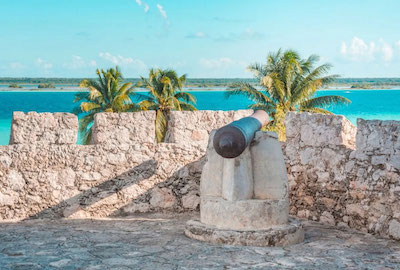
Fort of San Felipe
Built in 1733 to defend the town against recurrent pirate attacks. It is a formidable military structure with defensive walls, four corner bastions equipped with 11 iron cannons (it used to have 34 originally) and a moat that is 4 meters deep. In 1983 the star-shaped stone edifice has been restored to its former glory, and boasts with beautiful gardens, murals, and a museum.
It contains a small but fascinating collection of artifacts, including pre-Hispanic and colonial pieces, drawings, city maps, a beautiful mural and even the skeleton of a real pirate of the Caribbean. Hours: Tuesday to Sunday 9:00 to 20:00 hrs.
The 18th century fort has great views of the lagoon and surroundings, is one of the most Instagrammable spot in Bacalar.
Iglesia de San Joaquín
The Parish of San Joaquin is an 18th century colonial-style building with a stunning vaulted ceiling. Inside you can see murals representing the story of the Caste War and outside you can enjoy a nice garden.
According to urban legends, the church is said to be haunted by the ghosts of murdered people during the Caste War. If you are a ghosthunter or if you love mysteries, you should visit the church at night.
Casa Internacional del Escritor
The International Writer’s House is a spacious and comfortable facility for national and international writers and artists in general. It has hosted major national and international events such as the First National Meeting of Film Writers, First National Meeting of Directors of Film, and First International Diploma for Writers, among others.
Cenotes in BACALAR
Cenote Azul (Blue Sinkhole)
Located 2.5 miles from Bacalar’s downtown, it is a profound blue abyss, which connects with the Bacalar Lagoon. It is said to be the widest cenote in Mexico, measuring up to 200 meters (656 feet) across (it’s elliptical); beside it is 90 meters (300 feet) deep, with crystalline blue water, it means one of the deepest cenotes in the world.
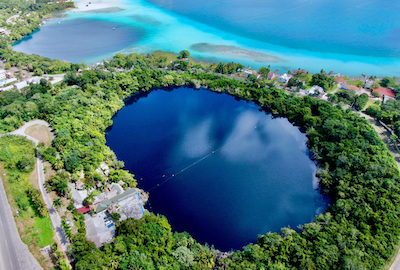
The deep blue waters are enhanced by the deep green tone of the mangroves and reed beds surrounding the cenote. The Cenote Azul is a must place for divers who visit the region represents a real challenge because the walls of the cenote dropped straight down to 170 ft. You will find intricate maze of roots and trunks intertwined and overlapping, holes of various sizes and rock formations on the walls.
The cenote has many caverns to explore, but you need an experienced guide and proper training. The cenote is also suitable for swimming and canoeing. On the shore there is a restaurant famous for its seafood. Hours: Daily from 9:00 to19:00 hrs.
You can arrive by boat, or pay a small fee to access the beach. It has a lovely area with hammocks and swings by the water to relax. This is one of the few places on earth where you can see living stromatolites, and it is also known as the Stromatolites Sanctuary. Hours: Daily from 8:00 to 18:00 hrs.
Cenote La Bruja (Witch’s Cenote)
Also known as Black Cenote, it has a submarine fracture in its depths. It is an open sky cenote with a diameter of 130 m. (427 feet). In a matter of feet, the water goes from a peaceful turquoise to an inky black, where a limestone cavern has collapsed into itself to a depth of almost 100 meters. Here you will experience a strong upward force.
It is surrounded with lush green vegetation and the turquoise blue waters swiftly drop off into a deep hole of pitch black magic. If you want to dive in this cenote you must be accompanied by an instructor, but it will be an unforgettable experience where you will find unique formations, walls and narrow canyons.
Cenote Cocalitos
It can be found approximately 2-3 kilometers out of town and has a diameter of 230 m (755 feet). The fresh water lagoon is feed by four underground cenotes and Cocalitos is one of them.
Cenote Esmeralda (Emerald Cenote)
It is a small cenote with an average depth of 70 m (230 feet) and you can see how the water gushes to the lagoon. Here you’ll be amazed by the different shades of blue.
Parque Ecoturístico Uchben Kah (Ecotourism Park)
The park covers 90 hectares on the northern shore of Lake Bacalar. It has excellent trails in the jungle for hiking and mountain biking. They offers various activities such as guided walks through the vegetation and interpretive trail to learn more about the local fauna like birds, tapirs and crocodiles.
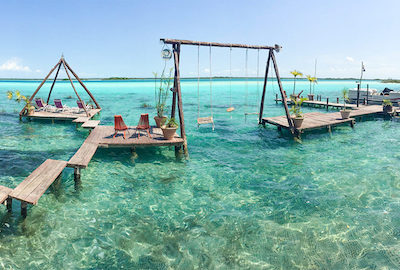
There is also an exciting night tour, where you can observe the crocodiles on the shore of the lagoon and the light from your headlamp may capture a surprised inhabitant.
You will arrive to discover the history of the town as told in the old hamlets. Walk the road of the town towards the museum of chewing gum and mahogany wood, where you can learn about the history, customs and occupations of the town’s natives. The park’s facilities have been adapted for a restaurant, store, bathrooms, dressing rooms, showers, snorkeling equipment rental, and ATM.
There are also camping areas and sections of the coast for aquatic recreations.
The Rapids of Bacalar
This is a narrow channel roughly halfway between Bacalar and Xul-Ha Lagoons. In this transparent water river the water runs quite fast from south to north and all along the shore. Kayaks are available for rent or you can simply let the current take you as you swim down with a life jacket.
The current is stronger in the middle of the river and there are two cords where you can hang on and resist the water flow, it’s not deep and for most of the time, you will be able to stand on your feet. In the rapids you can also admire the stromatolites, coral-like organisms found in only a handful of places around the globe. Like corals, the surface of the structures is fragile so please don’t touched or step on them.
Gastronomy of BACALAR
Its cuisine is a combination of Yucatecan and Belizean cuisine, some of the most representative dishes are: “rice and beans” cooked with coconut oil; tamales de xpelón (sort of bean tamales), the sotobichay, a tamale Chaya (tamales prepared with a leaf called chaya, a plant of the region), the tikinxic, fish marinated in achiote mixture; lobster and pan de cazón, a casserole dish using tortillas with shark meat, black beans and spiced tomato sauce.
Lagoon of Seven Colors - BACALAR
Bacalar lagoon is almost 60 kilometer long from Kah Uchben in the north to Xul-Ha in the south. It is the second longest lagoon in the country, after the Chapala lagoon, which is about 80 kilometers long. Bacalar is the entrance to an enormous river system in southern Quintana Roo. It is actually three irregular but parallel waterways.
Close by is another lake-and-marshlands system, Chile Verde, that drains low-lying marshlands north and east of the lake into Laguna Guerrero and the Bay of Chetumal.
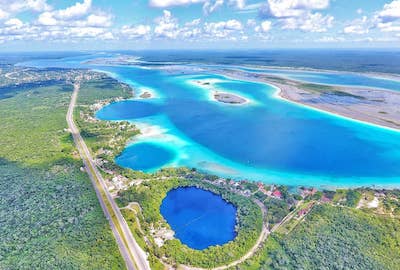
The southern end the lagoon is connected to the Río Hondo through the Chac channel. The ancient prosperous trade routes ran through the intricate water corridor, and today the visitors enjoy the lagoons striking no less than seven different shades of blue.
The peaceful Bacalar of today hides layers upon layers of history. It was founded in 1545 with the name Villa de Salamanca de Bacalar and with the years became the most important settlement on the eastern coast of the Yucatan Peninsula. Of all the valuable woods in the area, even above precious mahogany, it would be the fate of palo de tinte (Dye wood), to become the main target of exploitation for profit by the pirates and by the conquistadors.
The natives used the natural dyes from this timber- yielding leguminous plant to color fabrics, in dark colors such as black and dark blue. Nowadays, this natural dye is still used for various handicrafts and to dye some embroidered huipiles.
Until the mid-twentieth century logging camps in the north end of the lagoon used it as a major transportation route for native goods to get to Chetumal. In previous centuries the English pirates penetrated from Belize in search of valuable logwood (also called Palo de Campeche) and after the town was sacked in the 17th century, the Fortress de San Felipe was built to prevent the ravages suffered by the population from the pirates.
Considered one of the most beautiful lagoons in Mexico, the water is warm and beautifully crystal clear, morphing from bright turquoise to deep indigo colors as the depths of the lake change.
The peaceful Bacalar of today hides layers upon layers of history. It was founded in 1545 with the name Villa de Salamanca de Bacalar and with the years became the most important settlement on the eastern coast of the Yucatan Peninsula.
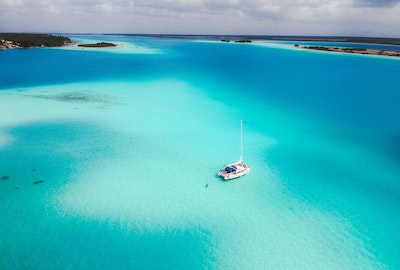
Of all the valuable woods in the area, even above precious mahogany, it would be the fate of palo de tinte (Dye wood), to become the main target of exploitation for profit by the pirates and by the conquistadors.
The natives used the natural dyes from this timber- yielding leguminous plant to color fabrics, in dark colors such as black and dark blue. Nowadays, this natural dye is still used for various handicrafts and to dye some embroidered huipiles.
Because the shores are quite weedy you don’t really want to walk in and swim from shore, and beside there aren’t really any easy access points to do this. Instead, look for one of the many docks along the shore that you can use to get into the water to swim off or rent a boat, jet ski or kayak.
Explore the shorelines across the lagoon a landscape filled with bright contrast colors, the lush green vegetation and different shades of blue. In the Uchben Kah Park there are guided tours to learn about the native flora and fauna, better preserved in the northern part of the lagoon.
This lagoon of shallow waters and soft sand, also called “of the seven colors”, is the area’s main attraction. This lake is part of a lagoon system of approximately 55 kilometers long. Inside the lagoon there are areas with some deep pools full of limestone formations ranging from gentle slopes to small cannons and real walls, this is a unique show for diving enthusiasts; the dives are very safe and ideal for beginners.
The Magical Town of Tulum is a must see and the best example of Mayan charm thanks to its ruins located on the edge of the Caribbean Sea; In addition to being the only archaeological zone that sits on the edge of a cliff, under which is the Playa del Paraíso, one of the best and most beautiful beaches in the Riviera Maya and most likely the most portrayed.
The old walled port of Tulum was inhabited until shortly before the arrival of the Spanish and was one of the most dynamic ports in the Mayan world approximately 1,500 years ago.
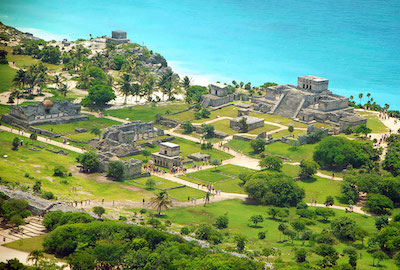
Tulum is the gateway to the Sian Ka’an Biosphere Reserve that was declared a World Heritage Site by UNESCO in 1987, an ecosystem of the most exuberant on the planet that includes beaches, coral reefs, an abundant tropical jungle, dunes and cenotes.
If you are an adventure lover, in Aktun Chen Park you can explore and have fun exploring the caves and underground rivers, or enjoy the natural landscape from a zip line. Another option is the Gran Cenote de Tulum, a majestic place that can be explored by diving and recognizing its caves. It is a place where marine fauna abounds, from this place diving excursions to the famous Mesoamerican Barrier Reef are organized.
It was an important Mayan port between the 13th and 16th centuries; its main constructions are from the late post-classical period. Around it there are abundant mangroves and swamps.
The area is rich in fine hardwood trees such as mahogany, cedar, and gum. The main crops are sapote, papaya, guava and coconut palm. The climate is warm subhumid and with rains in the summer. The average temperature of 26 ° C, classic for medium and low jungles.
The most representative dishes of this Mayan area are made from fish and shellfish, distinguishing the Tikin-xic, a fish baked underground or prepared on the grill, seasoned with achiote; You can also taste delicious garlic mojo shrimp, ceviches or a typical balché, fermented juice from the bark of the tree of the same name.
Tulum joined the Pueblo Mágicos Program in 2015.
History of TULUM
Tulum means “wall” in Mayan, and the reason for its name is given by the fortified enclosure that surrounds the perimeter of the city. Later it was renamed Zamá (“dawn”) since its orientation is towards the east where the sun rises, and it became a center of veneration for the deity known as “descending god”. An eminently Mayan city, it is thought that it may have had Mixtec influences as shown by some studied frescoes.
Inhabited at least since the 6th century AD. the period of greatest boom is circumscribed between the thirteenth century and the middle of the fifteenth century when the arrival of the Spanish began the decline of Tulum. Even after its abandonment, the towns near Tulum continued to make offerings that only the influx of tourism made disappear.
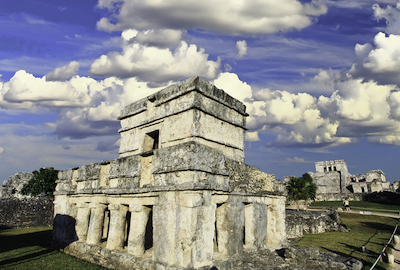
The importance of Tulum in pre-Hispanic cultures is due to its commercial enclave, which offered a stage and refuge in navigation along the coast, connecting Central America with Yucatán and the Gulf of Mexico.
The arrival of the Spanish to Tulum was preceded by the shipwreck of the ship Santa María de la Barca in 1511 due to a storm that capsized it on the coast. Of the survivors, only two managed to stay alive after contact with the natives, Jerónimo de Aguilar and Gonzalo de Guerrero, who knew how to adapt to coexistence with the Mayans after being captured, enslaved and taken to Tulum.
Seven years later, Juan de Grijalva, who left Cozumel to survey the different coastal settlements, spotted Tulum, being amazed at its size and the height of the buildings. The chroniclers compared it with Seville because of the high tower of the Mayan city, but by decision of the captain the ships did not anchor.
In that period Tulum lived a flourishing period, consolidating itself as a maritime enclave of coastal commerce. Hernán Cortés’ offer seduces Jerónimo de Aguilar, aware of the need to have translators available for negotiations during the conquest.
Gonzalo de Guerrero, married to the daughter of a Mayan president, not only refuses, but also continues his work of training the natives to resist the attacks of the Spanish, earning the nickname of El Renegado, while for the indigenous and especially to reinforce the American independence sentiment he will be called the Father of Mestizaje. Gonzalo de Guerrero will die years later in the Ulúa River (Honduras) fighting against the Spanish.
The Mayan Ruins of TULUM
The tour of Tulum leads through several spaces of different uses (religious, administrative, political or residential) with a suggestive route in front of the coast where the waves of turquoise water hit the cliff. Some of the buildings that we observe are the Great Palace, The House of Columns, the House of Halach Ulnic (both examples of residential architecture), the House of the cenote or the Temple of the God of the Wind, in addition to the Temple of the Descending God and the Castle.
The Castle
The Tulum Castle appears in any photo to be seen on the Mayan ruins of Mexico. The imposing building rises on the promontory of the cliff with two construction stages, consisting of several shrines on the sides of the access staircase. The lintel that is supported by two columns stands out where the figure of a serpent is carved.
El Castillo (name designated by the Spaniards due to its compact shape) could also serve as a guide building for coastal navigation, indicating the presence of the reef that runs parallel to the coast. Similar to western lighthouses, the building stood out for its height, an element that, like a compass, allowed to indicate maneuvers at sea.
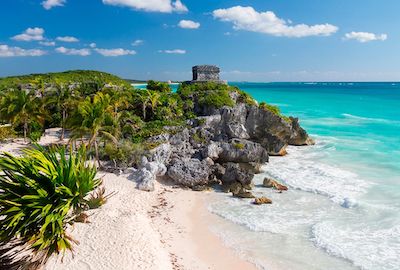
The Palace
Its breadth and housing distribution indicates that it housed a large number of nobles and leaders of Tulum. The decoration of the Palace shows carvings of gods such as Kukulcan, with an architectural style known as Puuc, and that we often find in Yucatán.
The original structure was designed in an “L” shape and later the west wing was added to meet the demands of population growth. The architectural style is consistent with the Puuc design, while its decoration includes carvings and images honoring deities such as Kukulkan.
Temple of the Descending God
Located next to the Castle, the Temple of the Descending God, served as a religious site of veneration to a deity spread in the territory.
Temple of the Frescoes
Profusely decorated with blue and green frescoes and a dark background, the Temple of the Frescoes was a religious complex made up of two complexes, one built on the other from an earlier stage.
Learn more about Tulum:
Other things to see in Tulum
Although the town of Tulum has no tourist interest, it is a perfect enclave to organize visits to other interesting destinations in the Riviera Maya such as Akumal beach, the archaeological zone of Coba, or further north the Eco Parks Xcaret, Xel-Ha or Xplor.
On the other hand, the Tulum Organic and Natural Market or Tianguis offers us the opportunity to buy and taste natural products from the area, such as organic fruit and vegetables, honey and other artisan products. It takes place on Saturday afternoons, from 3pm to 7pm. in Frida’s Garden.
Magic Towns in QUINTANA ROO
More Tourist Attractions in QUINTANA ROO
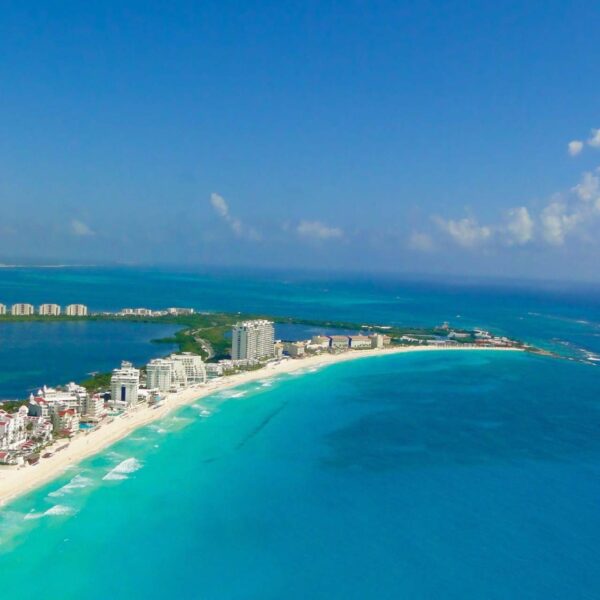
Cancun
Cancun is recognized around the world for its spectacular white sand beaches, its fascinating sea with turquoise blue waters and its unique climate. In addition, it has excellent air and land connectivity, as well as a first-rate hotel infrastructure that places it as one of the best tourist destinations in the world. Year after year Cancun is the destination chosen by national and international visitors thanks to the wide range of attractions and tourist places it offers such as: Mayan culture and history that can be enjoyed in its museums and archaeological sites, water activities, adventure tourism, great variety of gastronomic experiences, spectacular shopping centers as well as seductive entertainment offers for the whole family.… Read More
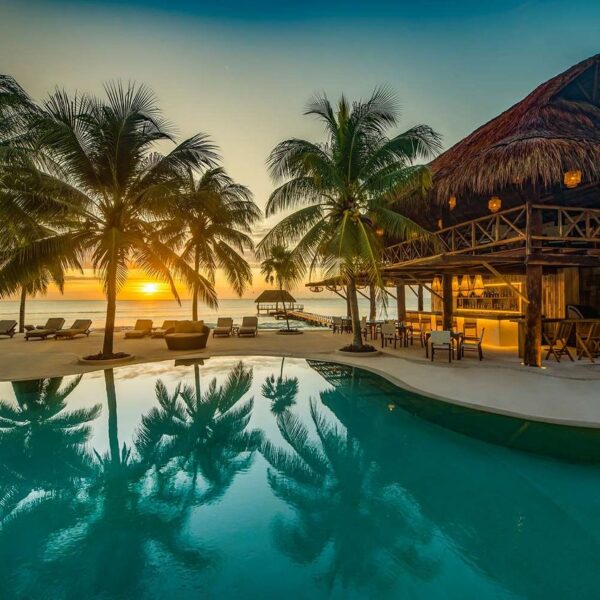
Riviera Maya
Riviera Maya offers wonderful beaches, turquoise waters and fine white sand, archeological sites, picturesque little towns, recreation centers, freshwater lagoons, underwater caves and cenotes, as well as ecological, and food and lodging options ranging from rustic cabins to gleaming condos, five-star hotels, and all inclusive accommodation. Here you can be seduced by an exquisite culinary tour, experiencing the regional cuisine prepared with the inherited Mayan recipes. About the nightlife, Riviera Maya has an exciting and cosmopolitan options with a wide variety of bars and nightclubs along the beach. It is an ideal setting for romance, making it a favorite of those who want a beach wedding or an unforgettable honeymoon.… Read More
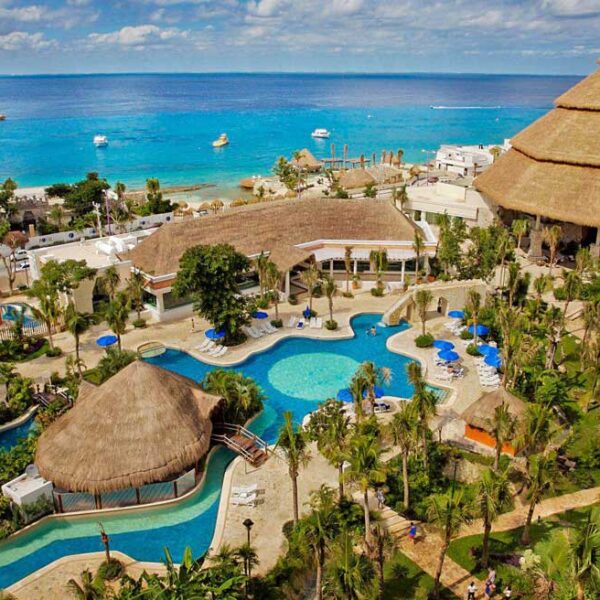
Cozumel Island
With a Mexican heart and a Caribbean soul, Cozumel is a paradise where tradition, flavor and joy come together. You will always find a friendly face and a warm welcome to make your stay an unforgettable one. Cozumel’s mostly undeveloped territory at the center of the island is covered by jungle and swampy lagoons, which are home to tiny mammals and endemic birds that have never left the island. Noteworthy is the Chankanaab National Park, a Cozumel icon, and the Punta Sur Ecological Reserve. This huge protected area at the southern tip of the island includes Punta Celarain and its historical lighthouse, as well as the Colombia Lagoon, a shelter for many of the island’s endemic species, as well as other endangered forms of life, such as marine turtles and their nesting areas.… Read More
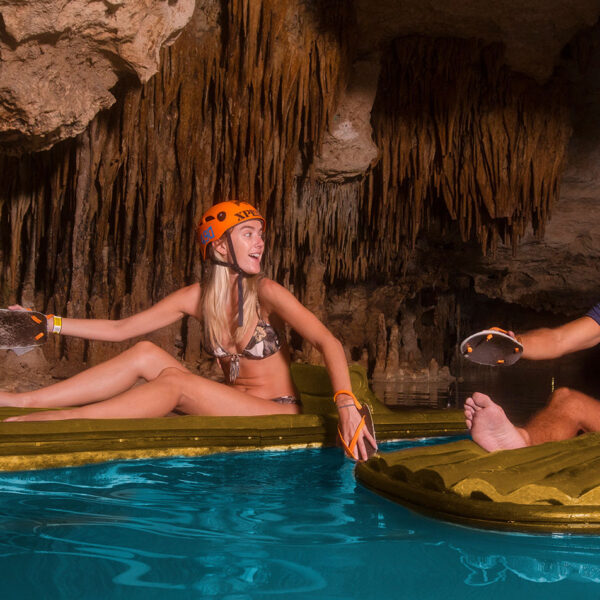
Eco Parks in Quintana Roo
Other options to experience adventure in Quintana Roo are the various natural, thematic, adventure, extreme and aquatic parks where in addition to living exciting and entertaining experiences it is possible to get in touch with nature. Xavage: It is an extreme adventure park with various activities that include a suspended rope circuit, a horizontal zip line, driving an all-terrain vehicle and rafting. Maya Park: Located in the hotel zone of Cancun, it offers a series of activities whose theme is “culture through adventure.” The tour begins with a video that tells the history of the Mayans, continuing with a zip line flight and boat rides through the Nichupté Lagoon. Finally, you will go through the Mayan Path, where you can participate in a Mayan dance and appreciate some elements of this culture.… Read More
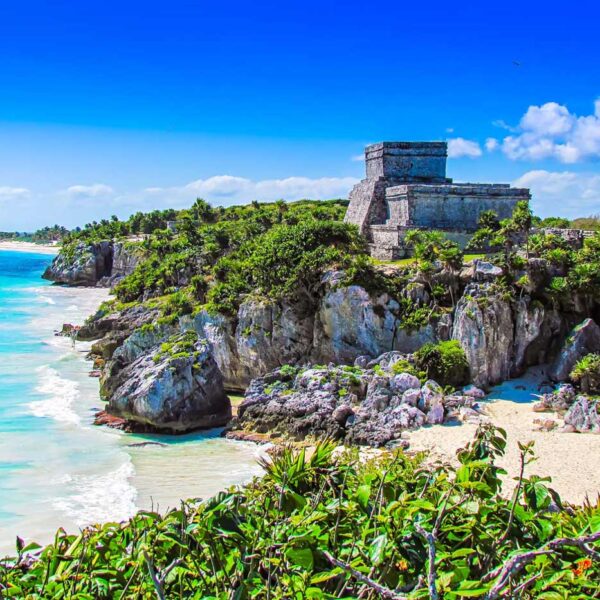
Tulum
The Archaeological Zone of Tulum is a must see and the best example of Mayan charm thanks to its ruins located on the edge of the Caribbean Sea; In addition to being the only archaeological zone that sits on the edge of a cliff, under which is the Playa del Paraíso, one of the best and most beautiful beaches in the Riviera Maya and most likely the most portrayed.… Read More
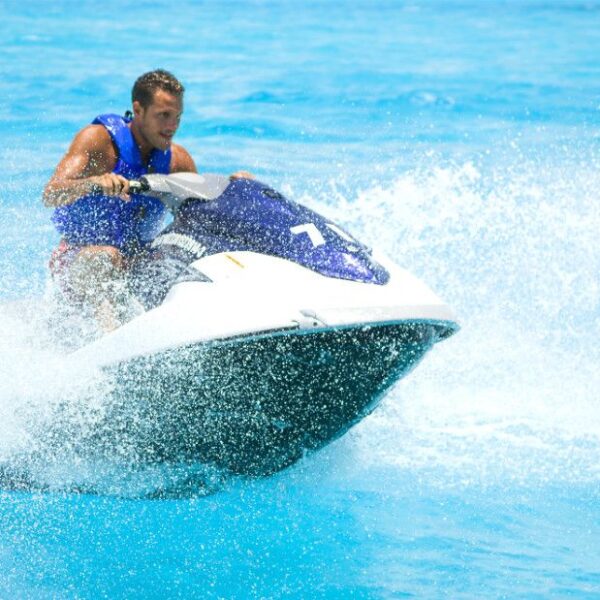
Water Sports in Cancun
In this destination you will find several marinas that offer water activities, with professional guides and operators who operate excellent fleets. There is an almost unlimited variety of activities, you can rent a jet ski or catamaran, take a tour through the mangroves driving a speedboat, travel in a submarine, snorkel in one of the reefs of Cancun, Cozumel or Puerto Morelos, or else dive in one of the sunken ships that are between Cancun and Isla Mujeres. Cancun has 23 kilometers of beaches of fine white sand and turquoise blue waters, considered among the best and most beautiful in the world. They are ideal for all kinds of water activities.… Read More
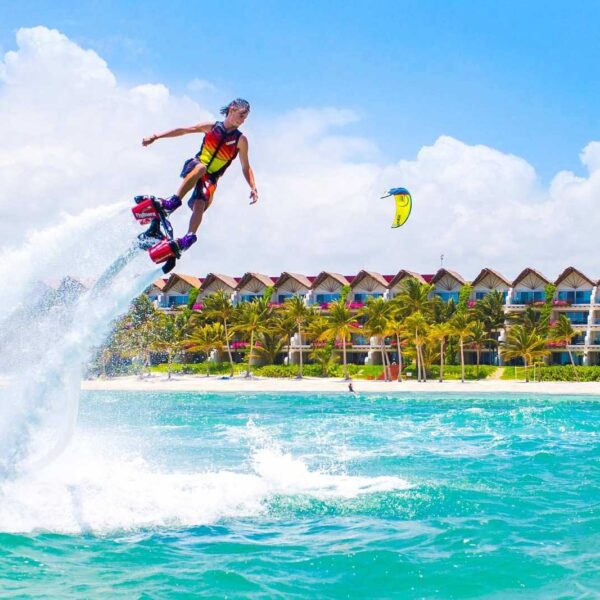
Water Sports in the Riviera Maya
The perfect climate and best weather for Water Sports can be found in the Riviera Maya! Enjoying a day under the bright sun, might be something you find hard to stop doing on your relaxed vacations, just the idea of leaving the comfort of the white sand beaches, but when you do you’re rewarded with clear waters for great visibility and year-round warm water, you won’t resist the idea of practicing great water sports. We offer a great variety of water activities for you to choose from, sports like jet skiing and wave runners, parasailing, snorkeling tours, scuba diving trips, swimming with dolphins and deep sea fishing trips that will get you out on the water and let you be active!… Read More
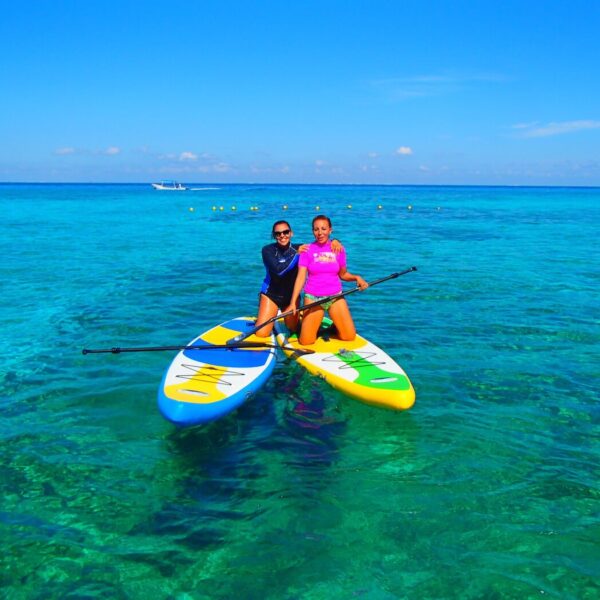
Water Sports in Cozumel
If you are looking for a place with diverse options where each member of the family finds interesting activities, Cozumel is one of the best choices: for the most daring, diving or snorkeling to get to know one of the most important reefs in the world, through kayaking, kite boarding and wind surfing for those who prefer to stay close to the shore, even sport fishing, for family members who prefer to spend a quieter time.… Read More
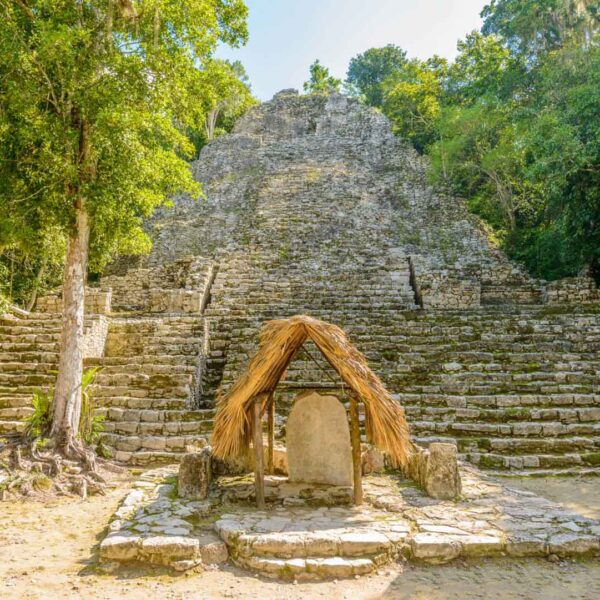
Archaeological Sites in Quintana Roo
Among the many attractions of Quintana Roo is having access to the vestiges of an ancient culture as fascinating as the Mayan culture. Just a few hours away you can visit several very important sites.The archaeological sites of the Mexican Caribbean can be visited any day of the week between 8:00 a.m. and 5:00 p.m., in some of them there are guides who speak several Languages. If you are passionate about archaeological remains, you can visit some in Cancun, Playa del Carmen, Xcaret and Xel-Há.… Read More
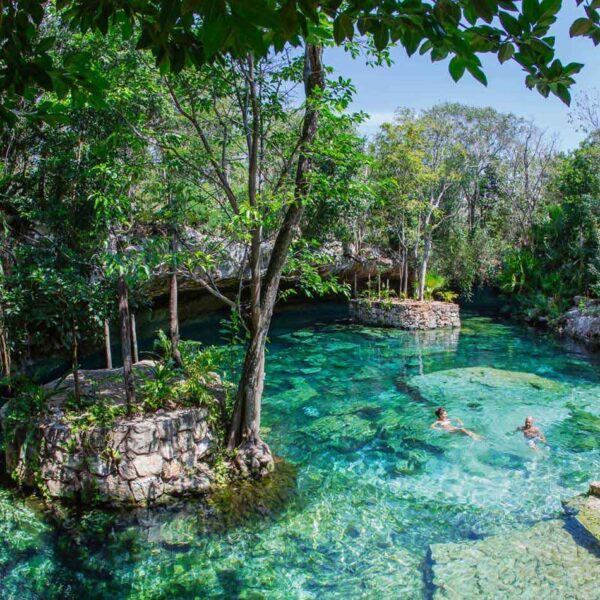
Ecotourism and Adventure in Quintana Roo
In Quintana Roo there are wonderful natural attractions such as the majestic mangroves, the exuberant jungle, the coral reefs, the mystical cenotes and the mysterious underwater caverns. In Cancun and some other destinations in the Mexican Caribbean, it is also possible to admire, live and learn about the conservation of different species of animals, as well as marvel at the diversity of flora characteristic of the area.… Read More
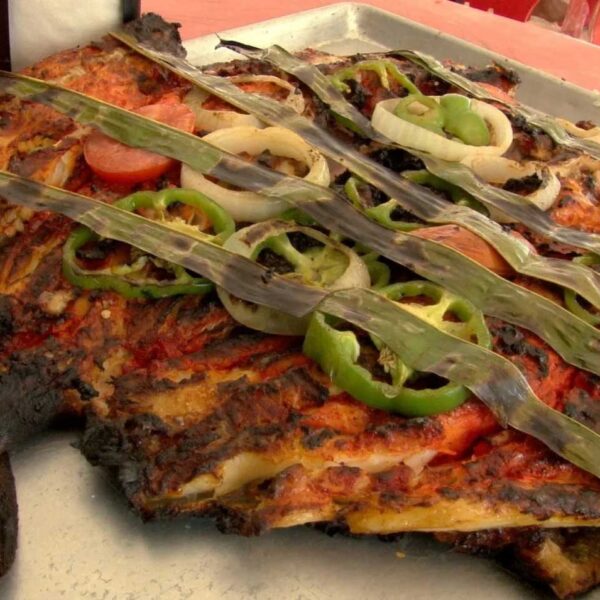
Gastronomy of Quintana Roo
The Gastronomy of Quintana Roo shares several elements with that of Yucatán and Campeche, in which traditional and contemporary cooking techniques are mixed. Although in places like Playa del Carmen and Cancun, where migrants from other countries live, the dishes have been enriched with international flavors. In regional cuisine, ingredients of pre-Hispanic origin are combined with those brought by the Spanish. The dishes of chicken, pork, beef and rabbit meat stewed and seasoned with oregano, purple onion, sour orange, sweet chili, pumpkin seed, tomato, achiote, habanero pepper and coriander stand out among other ingredients.… Read More
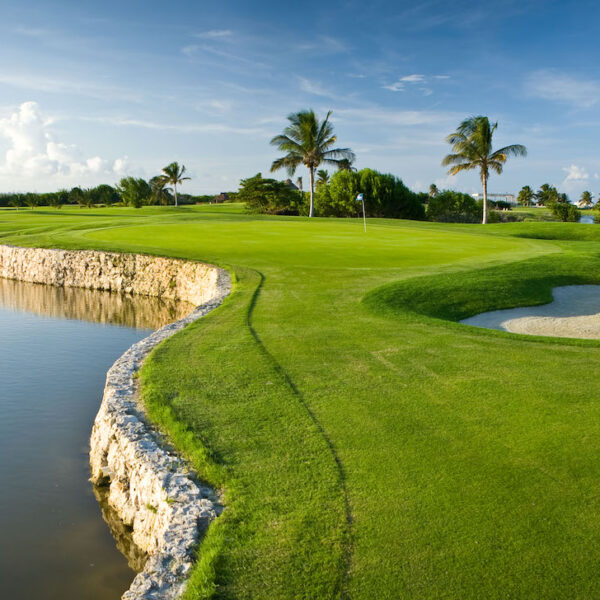
Golf Courses in Quintana Roo
The golf circuit in and around the Mexican Caribbean makes it one of the most competitive destinations both within and beyond our borders. It Offers 15 operating courses, other interesting golf complexes. In an advanced planning stage and the endorsement of international tournaments such as the PGA Tour at Mayakoba, the only PGA event to take place outside the United States and Canada. Cancun is on the verge of becoming México’s new golf leader, with seven courses in Cancun, another seven in La Riviera Maya and one more in Cozumel.
Courses are full-service venues, each with a professional pro shop, well-maintained golf carts, driving range, putting green, Bermuda fairways and greens, caddies, top quality equipment rentals, restaurants, and beverage cart. All the courses are open to the public (some require advance arrangements for access).… Read More
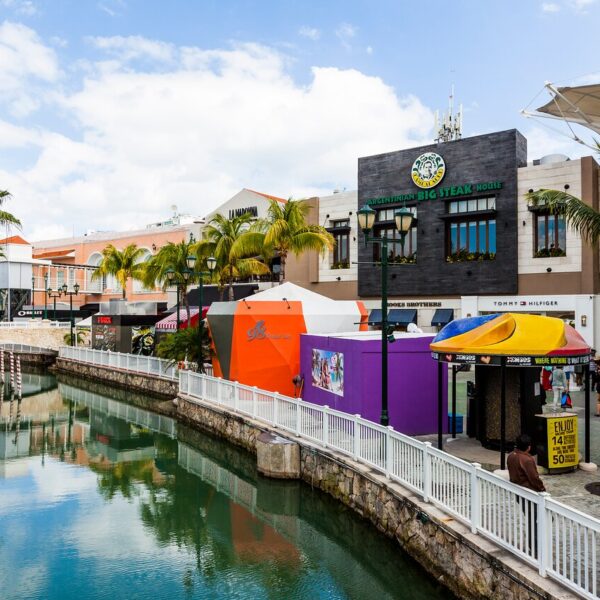
Shopping in Quintana Roo
The shopping experience in Quintana Roo every day becomes more sophisticated and cosmopolitan thanks to the wide variety of options that the destination offers. In addition, it is a duty-free zone for a wide range of items such as perfumery and cosmetics, as well as for wines and spirits, to name a few. There are exclusive and modern shopping centers in the hotel zone and in downtown Cancun with shops and boutiques that allow the visitor to find national and international renowned brands. Each shopping center has a unique architectural style, as well as an attractive range of services and entertainment options for the whole family.… Read More
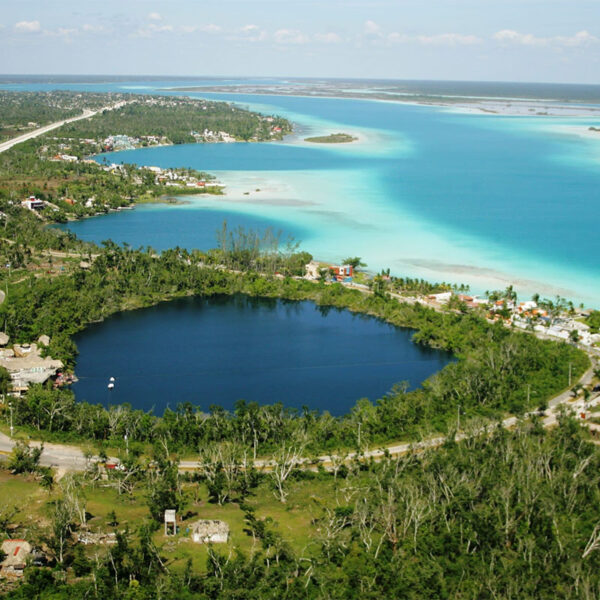
Chetumal
Costa Maya is located on the south of the Quintana Roo state and has many locations to choose from: a typical Caribbean enclave like Chetumal, a Magic Town like Bacalar, beautiful beaches like Mahahual and Xcalak and amazing Mayan sites such as Chacchoben or Kohunlich. Blessed with an unbeatable combination of tropical forest, wetlands, white-sand beaches, coral reefs, abundant wildlife and magnificent archaeological sites, Grand Costa Maya has long been one of Mexico’s best-kept secrets. This is an ideal place for adventure lovers as well as for people who loved Mayan culture, since several communities in here have preserved timeless traditions.… Read More
Guided Tours in BACALAR
Flights & Hotels in QUINTANA ROO
More Tourist Attractions in MEXICO

States Of Mexico
Mexico has an incredible diversity of landscapes, where the beauty of its beaches, internationally recognized, stands out. In its vast territory of coasts, there are beaches of unparalleled beauty, and colorful landscapes. A large network of first-class hotels and tourist services is available to visitors to these beaches. Mexico is also mystical places, dotted with archaeological testimonies inherited from its original inhabitants. Monuments made by the Mayas, Aztecs and Toltecs are located in magical landscapes, like lighthouses in an ocean of natural beauty. They offer visitors buildings that tell their history, and museums that collect their cultural heritage. And that keep alive ancestral traditions, in ceremonies and festivals, where you can enjoy cultural activities and entertainment.… Read More

Gastronomy
The Gastronomy of Mexico has a great diversity of typical dishes, which is why it was recognized by UNESCO as Intangible Heritage of Humanity. The basic and representative ingredients of Mexican dishes are: corn, coriander, chili, beans, piloncillo, nopal and tomato. Mexican cuisine is also characterized by its sauces, which serve as an accompaniment to traditional dishes, prepared based on spices.… Read More

Capital Cities
Folklore, gastronomy, literary culture, art and exhibitions, is what you will find in the capitals of the states of Mexico. To the north, colonial Mexico, Puebla, Guadalajara, Guanajuato, the Sonoran desert and the California peninsula. To the east Veracruz and the gulf. To the west Acapulco, Oaxaca and Tuxtla Gutiérrez. And to the south the Riviera Maya and the pyramids of Chichén-Itzá, Tulúm and Cobá in Yucatán, Palenque in Chiapas, the cenotes, and the Central American jungles.… Read More

Ecotourism and Adventure
Mexico is one of the best countries for Ecotourism as it has a great variety of flora and fauna, as well as a large number of refuges for extraordinary species. You can enjoy recreational activities of appreciation and knowledge of nature through contact with it, such as: stargazing, observation of natural attractions, wildlife and bird watching. Throughout México there are more than 176 protected natural areas, 5 of them considered by UNESCO as Natural Heritage of Humanity. Just for this and much more, we believe that Mexico is a Paradise for Ecotourism.… Read More

Archaeological Sites
The Archaeological Zones are the cultural past of every Mexican. You will be amazed at the ambient, nature and the environment that surrounds them. Climbing to the top or being around it will take us back in time to admire every detail. México is a country of culture and traditions, many of which we have inherited from the pre-Hispanic inhabitants of this vast territory, although it is true that there were more settlements in the central and southern part of the country, it is also possible to find some archaeological remains in the north.
… Read More

Magical Towns
A Magical Town is a place with symbols and legends, towns with history that in many cases have been the scene of transcendent events for our country, they are places that show the national identity in each of its corners, with a magic that emanates from its attractions ; visiting them is an opportunity to discover the charm of Mexico. The Magical Towns Program contributes to revalue a set of populations in the country that have always been in the collective imagination of the nation and that represent fresh and varied alternatives for national and foreign visitors. A town that through time and in the face of modernity, has conserved, valued and defended its historical, cultural and natural heritage; and manifests it in various expressions through its tangible and intangible heritage. A Magical Town is a town that has unique, symbolic attributes, authentic stories, transcendent events, everyday life, which means a great opportunity for tourist use, taking into account the motivations and needs of travelers.… Read More

Traditions in Mexico
It is practically impossible to make a meticulous, and above all, accurate selection of the places to visit in Mexico. Each place that our country houses is unique and beautiful in its own way. Mexico, with its nearly 2 million km², has a large number of scenarios to offer, as well as endless activities to do. Do not lose your way and enter the places to visit in Mexico. In Mexico, apart from the beaches and its famous archaeological sites, there are many other really interesting sites and activities that you should know. In the surroundings of the main cities you will find places full of culture and tradition, where you can spend relaxing, interesting and fun vacations. On your trip through Mexico you cannot stop obtaining souvenirs, the crafts that are made here are of the highest quality and recognized worldwide. A shopping tour cannot be missed.… Read More

Beaches
On the Beaches of Mexico you can immerse yourself in the intense blue ocean of the Pacific bays, sunbathe on the shore of the warm and transparent waves of the Caribbean Sea in Quintana Roo or even rest on the beautiful coasts of the Gulf of Mexico. Mexican beaches hide wonderful secrets for the traveler. By visiting them, in addition to enjoying the excellent climate and water activities, you can discover splendid archaeological sites and interesting colonial cities without traveling long distances.… Read More

